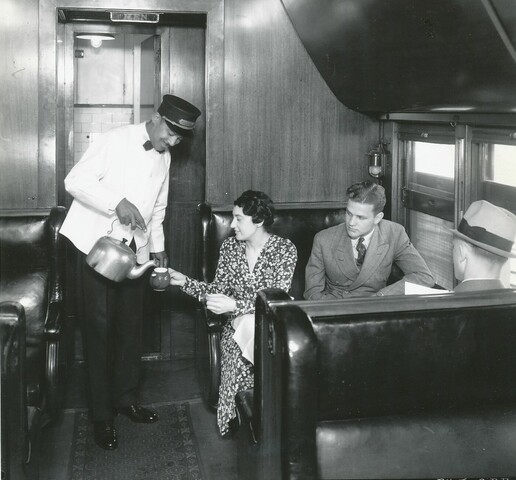
Unveiling Heroes: Stanley Grizzle
Stanley Grizzle
Porter serving tea in the tourist car. Image by Canadian Pacific Railroad. Courtesy of the CPR and Cranbrook History Centre
“Who’s Who in Toronto, Yorks Ridings,” Toronto Daily Star, June 6, 1959, p. 9.
Portrait of Judge Stanley Grizzle. ca. 2000, Toronto. Courtesy of the City of Toronto Archives.
Portrait of Stanley Grizzle. Image by Adeyemi Adegbesan. 2021. Courtesy of BSAM Canada
A Toronto youth
Stanley Grizzle was born in 1918 and grew up as one of seven siblings in Bathurst and College Street area of Toronto. His parents, Theodore and Mary Sinclair Grizzle, had arrived in Canada from Jamaica in 1911. Both of Grizzle’s parents worked to support the family: his mother as a domestic worker and his father as a taxi driver.
Grizzle’s family experienced the often-violent repercussions of Canada’s colour bar and widespread discrimination. When Grizzle was a young boy, his father was attacked with a razor while sleeping in his taxi, solely because of the colour of his skin. Grizzle’s experiences and exposure to racism and segregation in Toronto would have a profound effect on his life and legacy.
From railways to World Wars
When Grizzle was 22, he took a job as a sleeping car porter on the Canadian Pacific Railroad (CPR). Porters were responsible for serving the needs of passengers – from cleaning latrines to stowing luggage. Black men working as porters consistently faced institutional racism. Although Black porters in Canada had begun to organize as early as 1917 to collectively fight for better working conditions, the CPR was resistant to unions and, in the 1920s, fired 36 porters because of their association with labour groups.
In 1942, Grizzle was conscripted into the Canadian Army to fight in the Second World War. As a Black soldier, Grizzle was frequently assigned to ‘batman’ duties, such as shining shoes and tidying officer quarters. When he refused, he was punished with ‘honey bucket’ duty: cleaning toilets. Grizzle went on strike due to his treatment; he was eventually reassigned and promoted to corporal. When Grizzle returned to Canada in 1946, his wartime experiences of discrimination spurred him to become an advocate for the rights of Black Canadians.
The Brotherhood of Sleeping Car Porters
After returning to Canada from war, Grizzle continued his advocacy for civil rights. He resumed his work as a porter for CPR and was elected president of the Toronto chapter of the Brotherhood of Sleeping Car Porters in 1946. Grizzle called for improvements for Black porters working with the CPR. The union pushed for fair wages, individualized name plaques on the cars in which they worked, and more opportunities for promotion.
In the 1950s, Grizzle became a member of the Joint Labour Committee to Combat Racial Intolerance. Working with a coalition of activists, Grizzle lobbied the provincial government to introduce the first laws in Ontario to penalize businesses for discriminatory practices on the basis of race, ethnicity, and gender.
Dismantling the colour bar
Grizzle continued to fight for equal rights in Canada. In 1954, he was part of delegation of Black Canadians that confronted the federal government on its discriminatory immigration policies. At the time, policy heavily favoured white immigrants over immigrants of colour. Grizzle and the 1954 delegation helped to end race-based discrimination in Canadian immigration policy in 1962. This work helped to open Canadian immigration to a much wider pool of immigrants from within and beyond the Commonwealth.
In 1978, Grizzle was appointed as a judge in the Court of Canadian Citizenship by Prime Minister Pierre Trudeau. He was the first Black Canadian to be appointed to the court and held the position until 1983. In 1995, he was named a Member of the Order of Canada. Grizzle published his autobiography My Name’s Not George: The Story of the Brotherhood of Sleeping Car Porters in Canada in 1998. He died in 2016.
The Mighty Conductor
Titled “The Mighty Conductor,” Adeyemi Adegbesan’s portrait of Stanley Grizzle forms part of BSAM Canada’s “Unveiling Heroes of the Block” project. Adegbesan described the inspiration behind his artistic re-imagining of Grizzle: “The reference photo that I chose to use . . . is of him as a younger man and that was done intentionally as I felt this would be a better way of depicting the vitality and energy with which he approached his duties in the community.”
“In terms of his history as a railroad porter, I chose to symbolize that with the middle pendant that he is wearing which speaks to Canadian railways. The pendant on the left depicts his Order of Canada, which speaks to his political activism and his civil rights legacy and the pendant on the right speaks to his Jamaican heritage. The lion on his crown is a symbol of justice and leadership which in my mind symbolizes his role as a citizenship judge.”

